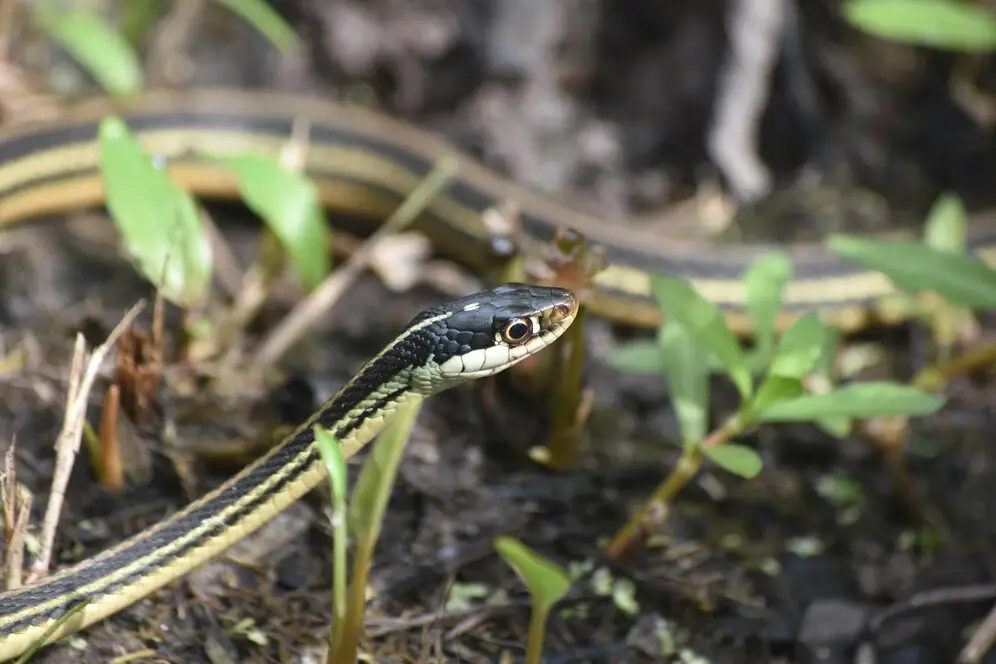Jake’s Unforgettable Lake Encounter: A Serene Outing Turned Profound Lesson in Wildlife Behavior
Introduction
What began as a routine day of fishing at a favorite lakeside spot became for Jake an encounter that challenged everything he knew about human–wildlife interactions. On the surface, the story reads like a curious footnote—an inquisitive snake, an out-of-place gesture of compassion, and a call to animal control. But beneath that lies a tapestry of ecological insight, psychological reflection, and practical guidance for anyone who ventures into nature. In this in-depth article, we explore:
-
The setting and background: why Jake chose this lake, its ecological significance, and regional wildlife norms.
-
The encounter itself: a moment-by-moment narrative of the snake’s approach, Jake’s surprising response, and the role of the animal control officer.
-
Ecological and ethological context: what science tells us about reptile behavior, hydration needs of wild snakes, and warning signs of distress or disease.
-
Psychological dimensions: the human impulse to help, curiosity versus caution, and the ethical considerations when wildlife seeks human assistance.
-
Practical takeaways: best practices for responsible wildlife viewing, when to intervene, and how to partner with local experts.
-
Broader reflections: what the episode reveals about our relationship with the natural world and how small surprises can leave lasting lessons.
Whether you’re an avid angler, a weekend hiker, or someone intrigued by animal behavior, Jake’s story offers valuable lessons—and perhaps a renewed sense of wonder—about the creatures that share our planet.
1. The Lake That Feels Like Home
1.1 A Personal Sanctuary
For Jake, the lake wasn’t just a body of water—it was his refuge. Nestled on the outskirts of town and ringed with mature oaks and pines, Cedarwood Lake (name changed for privacy) had been his special getaway for years. Every weekend, he’d haul his fishing gear across the weathered wooden docks, casting lines beneath cormorants perched high above. Whether reeling in bass at dawn or watching herons at dusk, Jake felt a sense of calm that erased work deadlines and personal stress.
-
Fishing as therapy: Angling isn’t just a sport; studies show it can reduce anxiety and promote mindfulness.
-
The power of place attachment: Regular visits to the same natural spot strengthen emotional bonds, making any unexpected event there especially jarring.
1.2 An Ecologically Rich Habitat
Cedarwood Lake lies within a mixed deciduous forest ecosystem. Its relatively shallow depth in the shallows supports emergent plants, while deeper channels sustain game fish. Typical wildlife includes:
-
Waterfowl: Mallards, wood ducks, and great blue herons.
-
Small mammals: Muskrats along the shoreline and occasional river otters.
-
Reptiles and amphibians: Painted turtles basking on logs, bullfrogs near reeds, and several snake species, including the non-venomous northern water snake.
Local naturalists note that interactions between humans and non-venomous snakes remain rare; reptiles usually avoid people. That’s why when a snake did not flee from Jake, alarm bells rang.
2. A Curious Visitor: The Encounter Unfolds
2.1 The First Glimpse
It was mid-morning, the sun high but filtered by thin clouds. Jake had arrived just after sunrise and spent the first hours managing lures and enjoying the shimmer of light on the water. Around 10:30 a.m., as he scrubbed algae from his tackle box, movement caught his eye:
“At first, I thought it was a stick,” Jake later recalled. “But it slipped across the sand almost eerily—too smooth, too deliberate.”
He looked up to see a slender snake gliding without hesitation toward him. Its scales were dark olive, patterned with faint crossbands—characteristic of the local water snake.
2.2 An Approach That Defies Expectation
Rather than a fleeting glance from the underbrush, the snake maintained steady progress. It paused about three feet from Jake’s seated position, tongue flicking in and out. What startled Jake wasn’t the proximity—it was the persistence.
“Every snake I’d ever seen would bolt or coil defensively. This one—nothing.”
He froze, rod in hand, watching as the creature seemed to regard him. After a moment, his surprise gave way to an impulse: what if it was thirsty?
2.3 The Impulsive Offering
Jake filled a clear glass with lake water—admittedly murky—and placed it gently near the snake’s path. He’d read somewhere that reptiles obtain moisture both through prey and by drinking standing water. It was a hunch.
Within seconds, the snake flicked its tongue, drew the glass’s rim to its jaw, and began to sip. Jake’s breath caught:
“It felt like a scene from a nature documentary—only I was the presenter.”
That surreal bond—a human and a wild animal sharing a simple glass—was brief but profound. Even so, Jake’s excitement carried an undercurrent of unease: this was not ordinary.
3. When Curiosity Meets Caution: Calling in the Experts
3.1 The Decision to Seek Professional Help
Despite the peaceful moment, Jake recognized that wildlife behaving abnormally could signal illness, toxin exposure, or environmental stress. He dialed the local animal control hotline, describing the species, behavior, and precise location.
Key considerations that prompted intervention:
-
Uncharacteristic tameness: Wild snakes typically avoid humans.
-
Potential health risks: Contaminated water could signal pollution or pathogens.
-
Public safety: Although non-venomous, any snake near human activity poses a bite risk if startled.
3.2 Officer Mark’s Arrival
Within twenty minutes, Animal Control Officer Mark Thompson arrived. With over a decade of field experience, Mark had seen his share of wildlife emergencies—injured raccoons, orphaned fawns, even the occasional escaped exotic pet.
Upon assessing the snake’s behavior, Mark’s demeanor grew serious:
“This isn’t normal. It could be neurological—maybe exposure to heavy metals, or it’s coming off brumation.”
He donned leather gloves and carefully coaxed the snake into a ventilated crate for further evaluation.
4. Understanding the Unusual: Science of Snake Behavior
4.1 Hydration in Wild Snakes
Snakes obtain moisture via:
-
Prey consumption: Fluids from amphibians, rodents, and other small animals.
-
Drinking surface water: Especially during dry spells or post-brumation emergence.
-
Absorbing dew: Some species lap dew off grass.
But direct human-provided water glass offerings are unheard-of in undisturbed habitats.
4.2 Signs of Distress or Illness
Veterinary literature identifies several red flags when snakes approach humans:
-
Ataxia: Uncoordinated movement indicating neurological issues.
-
Depression: Lethargy and lack of escape response.
-
Lesions: Skin sores from fungal or bacterial infections.
-
Paralysis: Often from snake fungal disease (Ophidiomyces ophiodiicola) or toxins.
Officer Mark noted no visible lesions but observed a slight tilt in the snake’s posture—suggestive of mild ataxia. A sample was sent to a wildlife rehabilitator for testing.
5. The Ecosystem Speaks: Lessons from Bird Behavior
5.1 The Bird Exodus
As Jake and Mark deliberated next steps, a flock of roughly fifty red-winged blackbirds abruptly rose from the cattails, chattering in alarm.
Why this matters:
-
Early warning: Birds often detect predators or environmental disturbances before humans.
-
Chemical cues: Panic flight can indicate airborne toxins or the presence of a terrestrial threat.
-
Sympatric awareness: Co-dependent species share habitats; one species’ distress can ripple across the community.
That synchrony—snake behavior, human intervention, bird panic—hinted at a deeper environmental trigger.
5.2 Investigating Environmental Factors
Mark widened his inspection:
-
Nearby runoff: Heavy rains two days earlier had swelled a farm drainage channel upstream.
-
Agricultural chemicals: The area grows seasonal corn and soy; recent pesticide application could have entered the lake.
-
Thermal stress: Unseasonably warm nights can stress cold-blooded reptiles.
Water samples were collected to test for nitrates, phosphates, and common pesticides. Bird droppings at the edge were also swabbed—analyzing what toxins birds may have ingested.
6. Ethical and Psychological Reflections
6.1 The Human‐Wildlife Bond
Jake’s impulse to help the snake speaks to a deep human instinct: compassion. Yet ethical wildlife care requires balancing benevolence with safety—for both the animal and people.
-
Do no harm: Even well-intentioned interventions can stress or injure wildlife.
-
Professional triage: Trained rehabilitators and veterinarians are best equipped to diagnose and treat.
6.2 When to Act—and When to Observe
General guidelines for wildlife encounters:
-
Observe from a distance: Use binoculars rather than approaching.
-
Avoid feeding: Human food or water can disrupt natural behaviors and diets.
-
Contact authorities: For injured or dangerously behaving animals, report to officials rather than handle them yourself.
Jake’s action—offering water—was benign but could have led to unintended consequences, such as habituating the snake to humans or exposing it to contaminated water.
7. Results from the Lab: What the Tests Revealed
7.1 Water Quality Findings
Laboratory analysis returned three days later:
-
Elevated nitrates (15 mg/L): Exceeding safe levels for aquatic life. Likely from upstream fertilizer runoff.
-
Trace pesticide residues: Low but detectable levels of atrazine and glyphosate breakdown products.
-
pH within normal range: 7.2, so acidity was not a factor.
7.2 Snake Health Assessment
The rehabilitator’s report noted:
-
Mild ataxia: Probably linked to nitrate-induced hypoxia (low dissolved oxygen).
-
No external injuries or lesions.
-
Full recovery expected: After a week in controlled habitat with clean water and proper diet.
7.3 Bird Sample Results
Bird droppings showed slightly elevated nitrates but no direct pesticide residues—suggesting they were reacting more to low oxygen levels or sensing fish distress (fish kills often precede mass bird flights).
8. Broader Implications and Community Response
8.1 Engaging Local Stakeholders
Jake and Officer Mark shared the findings with:
-
Local anglers’ association: To raise awareness of water quality issues.
-
County environmental health department: For upstream runoff mitigation.
-
Nearby farms: Discussing buffer zones and reduced fertilizer schedules.
8.2 Educational Outreach
A weekend workshop was organized at the lake pavilion, covering:
-
Responsible fishing and wildlife observation practices.
-
Citizen science water sampling protocols.
-
First-aid basics for wildlife emergencies (who to call, what to document).
9. Practical Takeaways for Nature Enthusiasts
-
Know your local wildlife: Learn typical behaviors to spot anomalies.
-
Carry observation tools: Binoculars, a small field notebook, and a camera with geotagging.
-
Avoid direct feeding or handling: Even water may carry contaminants.
-
Document and report: Photos, videos, and detailed notes help professionals diagnose.
-
Support habitat health: Participate in cleanups and advocate for responsible land use.
10. Conclusion: A Day That Changed Perspectives
Jake’s lakeside outing evolved from a simple fishing trip to a multi-layered lesson in ecology, empathy, and community stewardship. What first appeared as a quaint curiosity—an unusually brave snake—revealed deeper environmental concerns and underscored the delicate balance between humans and wildlife. By responding with both compassion and caution, Jake and Officer Mark not only aided one animal in distress but also catalyzed a broader conversation about water quality, habitat health, and our role as guardians of nature.
Next time you step onto your favorite trail or dock, remember: every ripple, every flutter of wings, every silent slither can carry a story—if only we take the time to look, listen, and learn.






